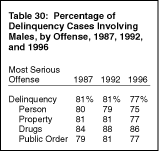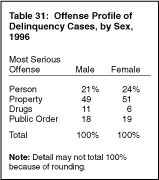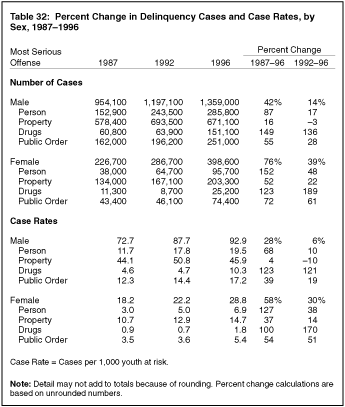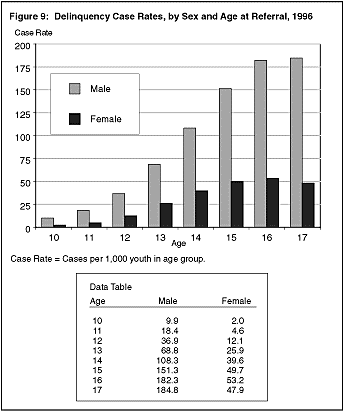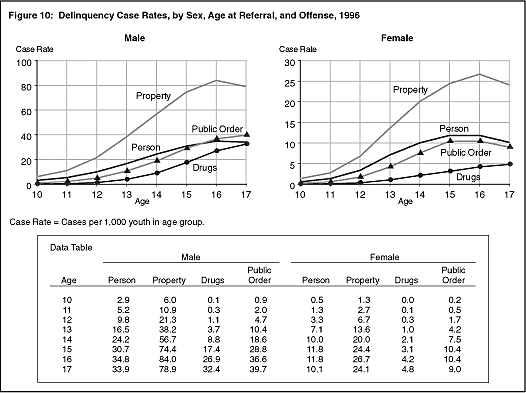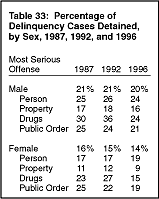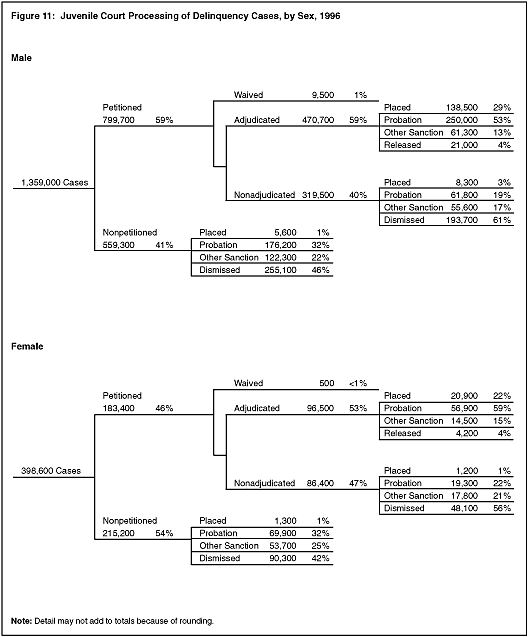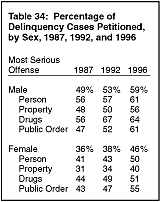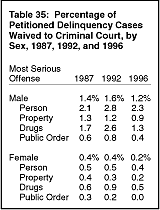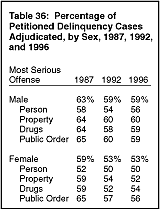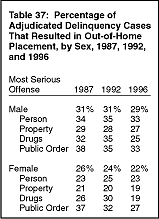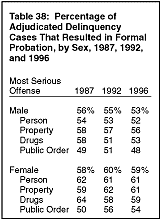|
Males were involved in 77% of the delinquency cases handled by juvenile courts in 1996 (table 30). Male juveniles were responsible for 75% of person offense cases, 77% of property offense cases, 86% of drug law violation cases, and 77% of public order offense cases. The offense characteristics of the male and female juvenile court caseloads were similar (table 31), although cases involving female juveniles were slightly less likely to involve drug law violations (6% compared with 11%) and more likely to involve person offenses (24% versus 21%).
Between 1987 and 1996, the number of delinquency cases involving males increased 42%, while the number of cases involving females increased 76% (table 32). Both males and females showed considerable growth in the number of person offense cases (87% and 152%, respectively). Among males, the largest percent change was in drug offense cases (up 149% between 1987 and 1996). Among females, there was also a large percent change in drug offense cases (up 123%), but the largest change was in person offense cases (up 152%).
In 1996, the delinquency case rate for males was more than three times greater than the rate for females—92.9 compared with 28.8. In 1987, however, the male case rate was about four times greater. Between 1987 and 1996, the relative change in delinquency case rates was greater for females than for males in all the major offense categories except drug law violations. Per capita case rates for person offense increased 127% for females and 68% for males; rates for property offenses increased 37% for females and only 4% for males; and rates for public order offenses increased 54% for females and 39% for males. On the other hand, the rate of drug offense cases increased more for males (123%) than for females (100%).
In 1996, overall delinquency case rates for both males and females increased with age through age 16, with a decline among female 17-year-olds (figure 9). Male case rates increased continuously with age in two of the four delinquency offense categories: drug law violations and public order (figure 10). For females, only the drug offense case rate increased continuously through age 17.
Detention
Male juveniles charged with delinquency offenses were more likely than females to be held in secure facilities while awaiting court disposition. Overall, 20% of male delinquency cases involved detention in 1996 compared with 14% of female cases (table 33). Both males and females were least likely to be detained in cases involving property offenses (16% and 9%, respectively).
Between 1987 and 1996, changes in the likelihood of detention were generally comparable for males and females. For most offenses, the use of detention changed only a few percentage points. Drug cases were an exception: for both males and females, the use of detention in drug cases increased between 1987 and 1990 and then dropped steadily through 1996. The change in the use of detention for public order offense cases involving females was also considerable: detention declined 6 percentage points between 1987 and 1996.
Intake Decision
Juvenile courts were less likely to use formal processing in delinquency cases involving females (46%) than in cases involving males (59%) in 1996 (figure 11). The likelihood of formal handling increased between 1987 and 1996 for both males and females in all offense categories (table 34). There was offense variation for both males and females in the proportion of cases petitioned for formal processing. In 1996, for females, cases involving public order offenses were most likely to be petitioned (55%), while for males, cases involving drug law violations were most likely to be petitioned (64%).
Judicial Decision and Disposition
Delinquency cases involving males in 1996 were six times more likely to be judicially waived to criminal court than were cases involving females. Overall, 1.2% of formally processed cases involving males were waived to criminal court, compared with 0.2% of cases involving females (table 35). The proportion of cases waived to criminal court was smaller for both males and females in 1996 than in 1987. Between 1987 and 1996, judicial waivers for formally processed cases involving drug offenses showed the same pattern for both males and females: a large increase between 1987 and 1992 and a substantial decrease between 1992 and 1996.
Cases involving male juveniles were more likely to be adjudicated once petitioned than were those involving females (59% compared with 53% in 1996) (table 36). This pattern was found in all four offense categories. For males, the probability of adjudication was greatest in cases involving property offenses (60%); for females, the probability was greatest in cases involving public order offenses (56%). The probability of adjudication decreased between 1987 and 1996 for formally handled cases involving males (from 63% to 59%) and females (from 59% to 53%). The probability of adjudication decreased in all offense categories for both sexes.
Adjudicated cases involving male delinquents were more likely than those involving females to result in residential placement (table 37). In 1996, residential placement was the most restrictive disposition in 29% of adjudicated cases involving males and 22% of those involving females. For both sexes, higher proportions of person and public order cases resulted in residential placement than did property or drug cases. Overall, the use of out-of-home placement declined slightly between 1987 and 1996 for both sexes.
Formal probation was ordered in 53% of adjudicated delinquency cases involving males and 59% of those involving females in 1996 (table 38). The likelihood of probation decreased slightly between 1987 and 1996 for cases involving males (from 56% to 53%) and increased slightly for females (from 58% to 59%).
|
